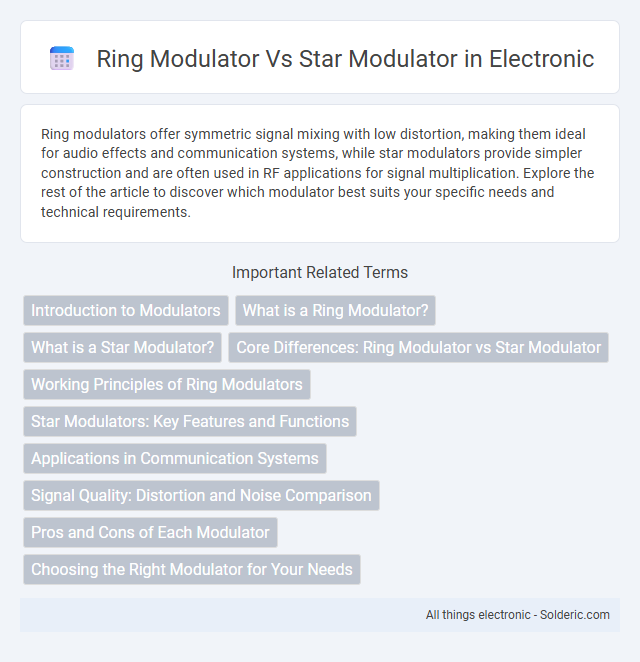Ring modulators offer symmetric signal mixing with low distortion, making them ideal for audio effects and communication systems, while star modulators provide simpler construction and are often used in RF applications for signal multiplication. Explore the rest of the article to discover which modulator best suits your specific needs and technical requirements.
Comparison Table
| Feature | Ring Modulator | Star Modulator |
|---|---|---|
| Topology | Diode ring forming a closed loop | Diode star (Y) configuration |
| Signal Output | Double-sideband suppressed carrier output | Double-sideband suppressed carrier output |
| Carrier Suppression | High carrier suppression | Moderate to high carrier suppression |
| Complexity | Simple diode ring circuit | More complex due to star topology |
| Usage | AM generation, frequency conversion, SSB modulation | Similar applications but less common than ring |
| Balanced Operation | Highly balanced, reduces distortion | Balanced but less effective than ring |
| Impedance Matching | Easier to achieve | More challenging |
Introduction to Modulators
Modulators are essential components in communication systems, enabling the transmission of signals by varying a carrier wave according to the information signal. Ring modulators employ a balanced bridge of diodes arranged in a ring configuration to produce double sideband suppressed carrier (DSB-SC) signals, known for their high linearity and low distortion. Star modulators utilize a star-shaped diode arrangement, offering simpler construction but typically less suppression of the carrier frequency compared to ring modulators, impacting signal clarity and efficiency.
What is a Ring Modulator?
A ring modulator is an audio signal processing device that multiplies two input signals, typically an audio signal and a carrier signal, to produce sum and difference frequencies, creating complex and metallic-sounding effects. It uses a ring of diodes arranged to switch signals in a balanced manner, enabling precise amplitude modulation without adding significant noise or distortion. Commonly used in electronic music and sound design, the ring modulator generates unique textures unlike the phase-based modulation found in star modulators.
What is a Star Modulator?
A Star modulator is a type of modulation circuit that uses a symmetrical star-shaped arrangement of diodes to mix two input signals, often resulting in a unique frequency output ideal for audio and communication applications. Compared to a Ring modulator, which employs a ring configuration of diodes, the Star modulator offers different harmonic characteristics and can produce distinct intermodulation products useful in sound synthesis. Understanding the differences between these modulators helps you choose the right device for your signal processing or musical experimentation needs.
Core Differences: Ring Modulator vs Star Modulator
The core difference between a ring modulator and a star modulator lies in their circuit topology and signal processing methods; ring modulators use a ring of diodes to multiply signals, often creating complex frequency mixing with symmetrical distortion characteristics. In contrast, star modulators utilize a star-shaped diode arrangement that can offer a more linear modulation response and different harmonic content. Your choice between the two will depend on the specific modulation sound texture and signal purity you require for your audio applications.
Working Principles of Ring Modulators
Ring modulators operate by utilizing a ring of diodes to multiply two input signals, producing sum and difference frequencies while suppressing the original carrier signals. This four-quadrant analog multiplier effect allows accurate amplitude modulation ideal for audio effects and signal processing. The diode ring configuration ensures balanced modulation with low distortion and high isolation between inputs.
Star Modulators: Key Features and Functions
Star modulators feature a symmetrical three-branch design that enables efficient mixing of multiple input signals, commonly used in high-frequency communications. Their balanced configuration minimizes distortion and crosstalk, ensuring cleaner modulation output compared to ring modulators. You benefit from enhanced signal clarity and stability in applications demanding precise amplitude or phase modulation.
Applications in Communication Systems
Ring modulators are widely used in communication systems for generating double-sideband suppressed carrier (DSB-SC) signals in amplitude modulation and demodulation applications, benefiting from their high linearity and suppression of carrier leakage. Star modulators, typically implemented with diode bridges, offer simpler construction and are frequently employed in frequency mixing and phase modulation tasks, especially where cost and size constraints dominate. Both modulators play crucial roles in RF signal processing, with ring modulators preferred in high-performance communication transceivers and star modulators favored in compact, low-cost wireless devices.
Signal Quality: Distortion and Noise Comparison
Ring modulators typically produce a cleaner output with lower distortion levels due to their balanced diode ring design, which efficiently cancels out unwanted carrier signals and reduces harmonic noise. Star modulators, although simpler and more compact, often introduce higher distortion and noise because their topology lacks the inherent carrier suppression found in ring modulators. Your choice of modulator will impact signal quality, with ring modulators preferred for applications demanding minimal distortion and superior noise performance.
Pros and Cons of Each Modulator
The ring modulator excels in producing clear, distinct frequency mixing with low distortion, making it ideal for musical applications requiring precise tone manipulation, but it can introduce unwanted noise due to its nonlinear characteristics. The star modulator offers better linearity and reduced harmonic distortion, which benefits communication systems needing cleaner signal modulation, yet it might be more complex to implement and less common in audio processing. Your choice depends on whether you prioritize tone clarity and simplicity or signal fidelity and complexity in modulation tasks.
Choosing the Right Modulator for Your Needs
Choosing the right modulator depends on your specific audio processing goals and signal requirements. A ring modulator excels in producing complex, metallic, and inharmonic sounds by multiplying two signals, ideal for experimental music and sound design, while a star modulator offers simpler amplitude modulation with less signal distortion, making it suitable for applications requiring cleaner output such as radio communication. Understanding the tonal characteristics and technical specifications of each modulator helps you optimize your sound processing setup for your unique needs.
Ring modulator vs star modulator Infographic

 solderic.com
solderic.com